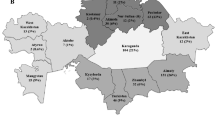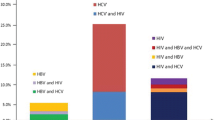Abstract
The prevalence of HIV infection in HCV patients is much lower than the prevalence of HCV infection in HIV patients. Whereas the higher prevalence of HCV infection in HIV is clearly related to drug abuse, the reasons for the lower prevalence of HIV infection in HCV patients has not been reported. The prevalence of non-sexual and sexual risk factors associated with acquisition of hepatitis C and HIV were studied in HIV-mono-infected, HCV-mono-infected, and HCV/HIV-co-infected individuals. None of the 114 HCV-mono-infected patients tested positive for HIV and this finding was associated with a significantly lower number of men who have sex with men (MSM) among the HCV-mono-infected subjects than among either the HIV-mono-infected or HCV/HIV-co-infected individuals. Unprotected anal intercourse and sex for money or drugs were reported less often by HCV-mono-infected individuals than by HIV-mono-infected and HCV/HIV-co-infected subjects. Having sex with an intravenous-drug user (IVDU) was reported more frequently by both HCV-mono-infected and HCV/HIV-co-infected individuals than by HIV-mono-infected individuals. Sub-analysis of the group of MSM revealed that IVDU differentiated between HIV-mono-infected and HCV/HIV-co-infected subjects. These results reveal that the lower prevalence of HIV in HCV patients is related to a lower number of MSM in this group and that sex with an IVDU is a surrogate marker for drug abuse related to acquiring HCV but not HIV. The guidelines should include strategies for testing for HCV and HIV in patients with these infections.


Similar content being viewed by others
References
Soto B, Rodrigo L, Garcia-Bengoechea M, Sanchez-Quijano A, Riestra S, Arenas JI, Andreu J, Rodriguez M, Emparanza JI, Torres Y et al (1994) Heterosexual transmission of hepatitis C virus and the possible role of coexistent human immunodeficiency virus infection in the index case. A multicentre study of 423 pairings. J Intern Med 236:515–519
Brau N, Bini EJ, Shahidi A, Aytaman A, Xiao P, Stancic S, Eng R, Brown ST, Paronetto F (2002) Prevalence of hepatitis C and coinfection with HIV among United States veterans in the New York City metropolitan area. Am J Gastroenterol 97:2071–2078
Alary M, Joly JR, Vincelette J, Lavoie R, Turmel B, Remis RS (2005) Lack of evidence of sexual transmission of hepatitis C virus in a prospective cohort study of men who have sex with men. Am J Public Health 95:502–505
Ghosn J, Pierre-Francois S, Thibault V, Duvivier C, Tubiana R, Simon A, Valantin MA, Dominguez S, Caumes E, Katlama C (2004) Acute hepatitis C in HIV-infected men who have sex with men. HIV Med 5:303–306
Gotz HM, van Doornum G, Niesters HG, den Hollander JG, Thio HB, de Zwart O (2005) A cluster of acute hepatitis C virus infection among men who have sex with men—results from contact tracing and public health implications. Aids 19:969–974
Ruys TA, den Hollander JG, Beld MG, van der Ende ME, van der Meer JT (2004) [Sexual transmission of hepatitis C in homosexual men]. Ned Tijdschr Geneeskd 148:2309–2312
Sulkowski MS (1999) Hepatitis C virus and HCV-co-infection: a sleeping giant wakes. Hopkins HIV Rep 11(3):10–12
Sulkowski MS, Thomas DL (2003) Hepatitis C in the HIV-Infected Person. Ann Intern Med 138:197–207
Alter MJ (1997) Epidemiology of hepatitis C. Hepatology 26:62S–65S
Nakashima AK, Fleming PL (2003) HIV/AIDS surveillance in the United States, 1981–2001. J Acquir Immune Defic Syndr 32(Suppl 1):S68–85
Krain A, Wisnivesky JP, Garland E, McGinn T (2004) Prevalence of human immunodeficiency virus testing in patients with hepatitis B and C infection. Mayo Clin Proc 79:51–56
Huckans MS, Blackwell AD, Harms TA, Indest DW, Hauser P (2005) Integrated hepatitis C virus treatment: addressing comorbid substance use disorders and HIV infection. Aids 19(Suppl 3):S106–115
Barros AJ, Hirakata VN (2003) Alternatives for logistic regression in cross-sectional studies: an empirical comparison of models that directly estimate the prevalence ratio. BMC Med Res Methodol 3:21
Lee J (1994) Odds ratio or relative risk for cross-sectional data? [letter]. Int J Epidemiol 23:201–203
Murphy EL, Bryzman SM, Glynn SA, Ameti DI, Thomson RA, Williams AE, Nass CC, Ownby HE, Schreiber GB, Kong F, Neal KR, Nemo GJ (2000) Risk factors for hepatitis C virus infection in United States blood donors. NHLBI Retrovirus Epidemiology Donor Study (REDS). Hepatology 31:756–762
Akhtar S, Moatter T, Azam SI, Rahbar MH, Adil S (2002) Prevalence and risk factors for intrafamilial transmission of hepatitis C virus in Karachi, Pakistan. J Viral Hepat 9:309–314
Pasha O, Luby SP, Khan AJ, Shah SA, McCormick JB, Fisher-Hoch SP (1999) Household members of hepatitis C virus-infected people in Hafizabad, Pakistan: infection by injections from health care providers. Epidemiol Infect 123:515–518
Weinbaum CM, Sabin KM, Santibanez SS (2005) Hepatitis B, hepatitis C, and HIV in correctional populations: a review of epidemiology and prevention. Aids 19(Suppl 3):S41–46
Author information
Authors and Affiliations
Corresponding author
Rights and permissions
About this article
Cite this article
Bollepalli, S., Mathieson, K., Jasiurkowski, B. et al. A Comparison of Risk Factors for HCV-mono-infection, HIV-mono-infection, and HCV/HIV-co-infection in a Community Setting. Dig Dis Sci 53, 517–521 (2008). https://doi.org/10.1007/s10620-007-9856-7
Received:
Accepted:
Published:
Issue Date:
DOI: https://doi.org/10.1007/s10620-007-9856-7




